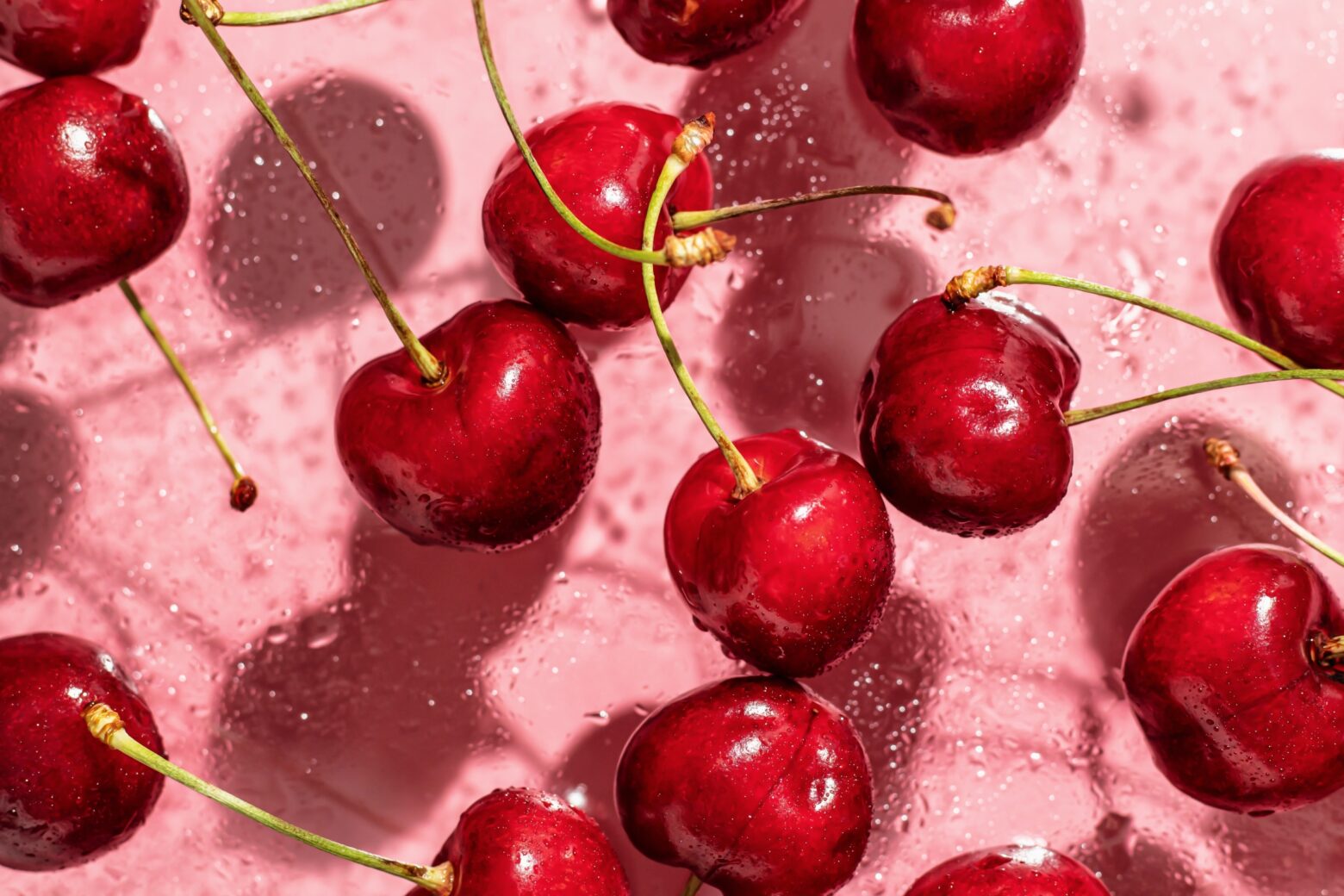Culinary Uses and Nutritional Benefits of Cherries

Cherries are one of the most beloved summer fruits—they’re sweet, tart, juicy, and bursting with antioxidants. While commonly enjoyed fresh, they’re also delicious in jams, mocktails, and desserts. Here’s what you may not have known about cherries and some tasty ways to enjoy them.
What Are Cherries?
Cherries are the fruit of various species in the Prunus genus, which also includes peaches, apricots, and plums. The most common edible types are sweet cherries (Prunus avium) and tart or sour cherries (Prunus cerasus).
Sweet cherries are typically larger and darker in color and are often eaten fresh. Tart cherries, on the other hand, are more acidic and commonly used in baking or dried snack mixes. [1]
Cherries are believed to have originated near the Black Sea and Caspian Sea regions; now Türkiye and Iran. From there, they spread throughout Europe and were brought to North America by early settlers in the 1600s. [2,3]
Today, the U.S. is one of the top producers of cherries, with Michigan known for its tart cherry crop and states like Washington, Oregon, and California leading in sweet cherry production.
Nutritional Benefits of Cherries
Cherries are more than just a sweet summer treat; they’re nutrient-dense fruits rich in vitamins, antioxidants, and anti-inflammatory compounds.
Antioxidant Power
Cherries are especially high in anthocyanins and polyphenols, antioxidants that give cherries their rich red and purple hues. These compounds help protect the body from oxidative stress and inflammation. They may even reduce the risk of chronic conditions like arthritis, heart disease, and cancer. [4,5]
Melatonin for Sleep
Tart cherries are a natural source of melatonin, the hormone responsible for regulating sleep-wake cycles. Drinking tart cherry juice before bed has been shown to improve sleep quality and duration in some people. [6]
Joint and Muscle Support
Athletes and those with joint pain may also benefit from consuming cherries. Tart cherry juice has been studied for its potential to reduce post-exercise soreness and support recovery. It’s also being researched for its role in managing symptoms of osteoarthritis and gout. [7,8]
Cardiovascular Health
Cherries may help regulate blood pressure and support heart health thanks to their potassium content and free radical-fighting polyphenols. Some studies suggest they may also help balance blood sugar levels due to their low glycemic index and fiber content. [9,10]
Elevated blood pressure and blood sugar are two key biomarkers for metabolic syndrome, a major risk factor for cardiovascular disease. Cherries may be a choice snack for those at risk.
How Cherries Are Cultivated
Cherry trees thrive in temperate climates with cold winters and warm summers. They need a certain number of “chill hours” to produce fruit, so they don’t grow well in tropical regions.
Sweet cherry trees typically take about four years to begin bearing fruit, while tart cherries may start producing a little earlier. These trees are prone to spring frosts, so careful site selection and frost protection methods are important. [11]
Harvest usually takes place early to mid-summer, depending on the region and variety. Cherries are picked by hand to avoid bruising and to maintain their delicate skin and stems.
How to Select & Store Cherries
When shopping for fresh cherries, look for ones that are firm, glossy, and richly colored. Sweet cherries range from deep red to nearly black, while tart cherries are often bright red. Avoid cherries that are soft, shriveled, or have brown spots. Stems should be green and flexible—a sign of freshness.
Store cherries unwashed in the refrigerator in a breathable container or produce bag. They’re best enjoyed within a week. Wash them right before eating to keep them from spoiling too quickly.
How to Prep and Enjoy Cherries
Cherries are incredibly versatile. You can enjoy them raw, baked into Paleo-friendly pies, blended into smoothies (or smoothie bowls), or dried as a snack. To prepare, rinse cherries under cold water and remove the stems. Use a cherry pitter (or a sturdy straw or chopstick) to remove the pits.
Here are some ways to enjoy cherries on The Paleo Diet®:
- Fresh by the handful or added to fruit salads
- Mixed into coconut-milk yogurt and topped with chopped nuts
- Blended into a Blueberry-Cherry Beet Smoothie for post-workout recovery
- Baked into a grain-free cherry crisp, pie, or clafoutis
- Stirred into grain-free granola
- Simmered into a homemade cherry compote for Paleo pancakes or waffles
- Dried and added to trail mix or salads
- Frozen for use in sherbert or sorbets
Cherries pair well with almonds, dark chocolate, balsamic vinegar, and fresh herbs like mint and basil. They’re even good with savory dishes like Seared Pork Chops with Sweetheart Spinach. Whether you like them fresh or cooked, cherries add vibrant color, natural sweetness, and a healthy boost to many dishes.
References
- Kelley D, Adkins Y, Laugero K. A Review of the Health Benefits of Cherries. Nutrients [Internet]. 2018 Mar 17;10(3):368. Available from: https://www.ncbi.nlm.nih.gov/pmc/articles/PMC5872786/
- Kappel F, Granger A, Hrotkó K, Schuster M. Cherry. Fruit Breeding. 2011 Nov 21;459–504. Available from: https://link.springer.com/chapter/10.1007/978-1-4419-0763-9_13
- Cherry Facts – California Cherries [Internet]. calcherry.com. Available from: https://calcherry.com/facts/
- Ferretti G, Bacchetti T, Belleggia A, Neri D. Cherry Antioxidants: From Farm to Table. Molecules. 2010 Oct 12;15(10):6993–7005. Available from:
https://www.mdpi.com/1420-3049/15/10/6993 - Kelley DS, Rasooly R, Jacob RA, Kader AA, Mackey BE. Consumption of Bing sweet cherries lowers circulating concentrations of inflammation markers in healthy men and women. The Journal of Nutrition [Internet]. 2006 Apr 1;136(4):981–6. Available from: https://pubmed.ncbi.nlm.nih.gov/16549461/
- Howatson G, Bell PG, Tallent J, Middleton B, McHugh MP, Ellis J. Effect of tart cherry juice (Prunus cerasus) on melatonin levels and enhanced sleep quality. European Journal of Nutrition. 2011 Oct 30;51(8):909–16. Available from: https://pubmed.ncbi.nlm.nih.gov/22038497/
- Connolly DAJ. Efficacy of a tart cherry juice blend in preventing the symptoms of muscle damage * Commentary 1 * Commentary 2. British Journal of Sports Medicine. 2006 Apr 12;40(8):679–83. Available from: https://pubmed.ncbi.nlm.nih.gov/16790484/
- Chen PE, Liu CY, Chien WH, Chien CW, Tung TH. Effectiveness of Cherries in Reducing Uric Acid and Gout: A Systematic Review. Evidence-Based Complementary and Alternative Medicine: eCAM [Internet]. 2019;2019:9896757. Available from: https://pubmed.ncbi.nlm.nih.gov/31885677/
- Keane KM, George TW, Constantinou CL, Brown MA, Clifford T, Howatson G. Effects of Montmorency tart cherry (Prunus Cerasus L.) consumption on vascular function in men with early hypertension. The American Journal of Clinical Nutrition. 2016 May 4;103(6):1531–9. Available from: https://pubmed.ncbi.nlm.nih.gov/27146650/
- Moosavian SP, Maharat M, Chambari M, Moradi F, Rahimlou M. Effects of tart cherry juice consumption on cardio-metabolic risk factors: a systematic review and meta-analysis of randomized-controlled trials. Complementary Therapies in Medicine. 2022 Aug;102883. Available from: https://pubmed.ncbi.nlm.nih.gov/36038032/
- Almanac OF. Cherries [Internet]. Old Farmer’s Almanac. Available from: https://www.almanac.com/plant/cherries
Betsy Schroeder
Betsy does research and writing for a few different websites in the natural health field after taking Masters level courses in Nutrition & Functional Medicine through the University of Western States.
More About The Author




